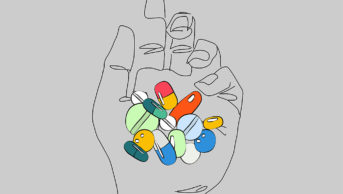
Shutterstock.com
Medicines provide some of the safest and most effective treatments in the world. But all too often, these treatments are used in ways that undermine their value: they are prescribed when they shouldn’t be; they are not prescribed when they should be; and patients often take them incorrectly or combine them with over-the-counter (OTC) medicines or supplements in ways that pose potential harm. Also, the costs of certain medicines can be prohibitive because many patients cannot afford them.
Taking a multitude of medicines, whether they are prescription drugs, OTC treatments, herbal or dietary supplements — known as polypharmacy — is not only a burden for patients, it can be dangerous. We need a way to mitigate the danger of unwanted drug interactions and improve drug adherence to essential medicines, and this is as true for the United States as it is in Europe. It is imperative that patients are empowered to make informed decisions about the medicines they are taking, and pharmacists and other healthcare professionals have an important role in educating patients to make these decisions.
What is polypharmacy?
There is no single definition of polypharmacy, although it is often defined as the use of five or more medicines on a daily basis[1]
. This may be any combination of prescription drugs, OTC medicines and dietary or herbal supplements. Others use the term to refer to the experience of adverse effects from taking multiple medicines simultaneously, regardless of the number. In an analysis of a longitudinal, nationally representative study that we conducted in 2015, we found that 35.8% of adults in the United States were taking five or more medicines[2]
. Statistics are similar elsewhere – a 2014 analysis of Scotland’s electronic primary healthcare records showed that 16.9% of adults were receiving four to nine medications. That number rose to 28.6% for adults aged 60–69 years and to a whopping 51.8% of the population aged over 80 years[3]
.
Although many drugs are safe when taken correctly, their associated risks can increase considerably when combined with other treatments. The more drugs one takes, including a substance as innocuous as a vitamin, the higher the risks of a drug-drug interaction, an adverse drug event or non-adherence. Moreover, keeping up with a lengthy and complicated drug regimen is difficult.
How did we get here?
It is important to note that polypharmacy is not a luxury that most of the world has to worry about. For the majority of the world, problems of access to drugs and affordability abound. Nevertheless, there are several drivers that have created the perfect storm for hundreds of millions of individuals living in developed economies around the globe. First, we are living longer than ever before – life expectancy at birth in developed countries ranges from 76 years to 80 years. In the United States, the proportion of the population aged 65 years and older is projected to increase from 12.4% in 2000 to 19.6% in 2030[4]
. From 2000 to 2030, the worldwide population aged 65 years and older is projected to increase by approximately 550 million to 973 million (15.5% to 24.3% in Europe, 6% to 12% in Asia)[4]
.
As life expectancy has increased, so too has the prevalence of chronic medical conditions, such as arthritis, osteoporosis, cardiovascular disease and cancer[1]
[5]
. Increases in the prevalence of type 2 diabetes in some countries, such as the United States and the UK are especially stark[6]
. In 1995, 4.5% of the US population aged over 18 years had been diagnosed with diabetes. By 2010, diagnoses had nearly doubled to 8.2% of the population, an increase of 82.2%[6]
. In the UK, the number of people diagnosed with diabetes since 1996 has increased from 1.4 million to almost 3.5 million[7]
. Polypharmacy has also arisen from the success of pharmaceutical research and development to bring to market treatments for common and chronic diseases, such as hypertension, hyperlipidaemia, osteoporosis and chronic kidney disease, and of the willingness of consumers, governments and society to pay for them.
Complicating matters further, many people like to take medicines, and physicians and other healthcare providers like to prescribe them[8]
. It has long been said that a doctor’s visit is not complete without a prescription for medicines and, all too often, such prescriptions add to a long list of treatments that the patient has already been prescribed or is pursuing on their own accord.
In addition, many healthcare systems are fragmented. In the United States, patients move between primary care physicians and specialists, and without the existence of a nationwide electronic medical record system, many prescribers do not have a clear picture of their patient’s medical history[9]
. Thus, specialists and primary care physicians may treat a patient without knowledge of what the other is doing[6]
.
Throw into the mix effective drug marketing and the widespread availability of OTC treatments and dietary supplements and you have the perfect storm
Polypharmacy is certainly not unique to privatised healthcare systems, however. A shortage of GPs, or primary care physicians, in the UK has caused longer waiting times and shorter visits[10]
. Patients waiting weeks to see their physician may be taking a problematic medicine for longer than necessary, experiencing side effects or symptoms for weeks without receiving help and advice, or they may have started a medicine or supplement without consultation. Shorter visits impinge on the time physicians have to review their patient’s medicines or discuss with patients how to take their medicines correctly. Additionally, the Quality and Outcomes Framework, UK GPs’ annual reward and incentive programme, can put undue emphasis on prescribing medicines to improve singular or immediate conditions rather than a managing a patient’s long-term health[11]
. And, increasingly, medicines that may make good sense in isolation may have a different risk-benefit balance when combined with other medicines that a patient may be taking[12]
.
Patients are also increasingly relied on to provide an accurate summary of each medicine they are taking, yet many have low health literacy. A third of older adults in England have difficulties reading and understanding basic health-related information, but are expected to be knowledgeable about an often complicated health regimen[13]
. Throw into the mix effective drug marketing and promotion, and the widespread availability of OTC treatments and dietary supplements for symptoms and conditions ranging from indigestion to cardiovascular disease, and you have the perfect storm.
What are the risks?
Polypharmacy is not just an inconvenience. The more medicines and supplements a patient takes, the higher their risk of adverse events, including serious ones, from these combinations, rather than from the underlying illnesses they are designed to treat. In some cases, these adverse events arise because it becomes complicated to coordinate so many treatments[14]
. But in other cases, the risks are caused by the treatment combinations themselves[2]
.
For example, in a landmark study of adults receiving one or more prescriptions from their primary care physician, published in the New England Journal of Medicine, the authors found that 25% of patients had an adverse drug reaction within three months of starting their prescriptions. While 39% of these were preventable errors, most were the result of inappropriate drugs or drug interactions[15]
. An analysis of prescription drug data among older people in Sweden found that those taking 5 to 7 medicines were 4 times more likely to experience a drug-drug interaction; those taking 8 to 10 medicines were 8 times more likely to experience an interaction; and those taking 14 to 16 medicines daily were 20 times more likely to experience these events[16]
.
Although these estimates are noteworthy in their own right, they understate the magnitude of potential adverse events that result from polypharmacy because it is often difficult for researchers, patients and healthcare providers to tell the difference between adverse drug effects and symptoms, such as nausea, dizziness or even death, that may reflect progression of an underlying disease[1]
.
What about OTC products and supplements?
The combination of prescription drugs, OTC treatments and dietary supplements adds further complexity. In many cases neither healthcare providers nor patients consider dietary supplements to be medicines, and thus they are often neglected in the course of clinical care. However, just because they may not be discussed, it does not mean that patients are not taking them. More patients are using dietary supplements than ever before and combining them with prescription drugs poses potentially serious risks, as does the combination of prescription drugs with OTC medicines.
For example, combining the blood thinning medicine warfarin with aspirin can increase the risk of major bleeding, such as gastrointestinal or intracerebral haemorrhage[17]
. Similarly, the combination of angiotensin-converting enzyme (ACE) inhibitors, commonly used to treat high blood pressure and heart failure, with OTC potassium supplements, can cause life-threatening elevations of potassium in the blood[18]
. In a nationally representative sample of older adults in the United States, we found that, in 2011, 15% of those patients regularly using at least one dangerous drug combination were potentially at risk of a major drug-drug interaction[2]
. In rare cases, even something as innocent as a herbal remedy, like ginseng or gingko, may pose a danger when combined with other drugs[19]
.
Almost half of Canadians take herbal products on top of their medicines, and one in five combine at least one prescribed medicine, one herbal product and one OTC medicine regularly[20]
. In Japan, nearly 30.7% of healthy subjects and 39.1% of ambulatory patients take dietary supplements, with almost 70% reporting that they do not mention dietary supplement use to their doctors[21]
. In the United States, we recently reported that more than two-thirds of older adults were concurrently using prescription and OTC medicines between 2010 and 2011, including dietary supplements[2]
.
Review and deprescribe
For all of the tens of billions of pounds and dollars that are invested in figuring out when to start taking medicines, it is remarkable that we spend so little effort learning about when to stop them. As with any other symptom or medical problem, treatment must begin with a diagnosis, in this case, of polypharmacy. Such a diagnosis has be to be based on consideration of OTC treatments and dietary supplements as well. This is not about prescription medicines alone.
The most important thing that patients can do is to learn about their medicine and why they are taking them, and to ensure that each provider or prescriber that they see is aware of the totality of treatments that they are using. Services, such as medicines use reviews or the new medicine service in England, conducted by pharmacists, are ways to educate patients about their medicines and to ensure their medicines are appropriate and taken correctly.
Patients should not start supplements or vitamins before asking their physician or pharmacist about any possible side effects or drug interactions. GPs and pharmacists have major roles to play to ensure drug interactions are minimised, particularly when patients are looking to purchase OTC treatments or herbal/dietary supplements.
In terms of self care, patients, with guidance from a healthcare professional, should make use of databases intended to identify potential adverse interactions between medicines such as the Drug Interactions Checker at drugs.com[22]
, Medscape’s Drug Interaction Checker[23]
, and other similar resources. Although the quality of online resources are variable, they can serve as helpful starting points for a formal conversation between patients and their doctor or pharmacist.
Polypharmacy is an unfortunate consequence of medical advancement. We are living longer and more medicines are being discovered to treat more chronic medical conditions. The irony is that the drugs meant to improve patients’ health have the potential to more illness and sometimes even harm. Healthcare professionals need to be vigilant in their care of patients who are taking multiple medicines and, where necessary, reduce or amend regimens and provide suitable education about drug use to patients.
Kira Barrett is a high school senior at the Friends School of Baltimore. Eleanor Lucas is a research assistant and G Caleb Alexander is associate professor of epidemiology and medicine and co-director of the Center for Drug Safety and Effectiveness, both at the Johns Hopkins Bloomberg School of Public Health in Baltimore, Maryland.
References
[1] Fulton MM & Riley Allen E. Polypharmacy in the elderly: A literature review. Journal of the American Academy of Nurse Practitioners 2005;17:123–132. PMID: 15819637
[2] Qato DM, Wilder J, Schumm LP et al. Changes in prescription and over-the-counter medication and dietary supplement use among older adults in the United States, 2005 vs 2011. JAMA 2016;176:473–482. doi: 10.1001/jamainternmed.2015.8581
[3] Payne RA, Avery AJ, Duerden M et al. Prevalence of polypharmacy in a Scottish primary care population. European Journal of Clinical Pharmacology 2014;70:575–581. doi: 10.1007/s00228-013-1639-9
[4] Centers for Disease Control and Prevention. Trends in ageing – United States and worldwide. Morbidity and mortality weekly report 2003;52:101. Available at; http://www.cdc.gov/mmwr/preview/mmwrhtml/mm5206a2.htm (accessed 12 May 2016)
[5] Hunt LM, Kreiner M & Brody H. The Changing Face of chronic illness management in primary care: a qualitative study of underlying influences and unintended outcomes. Annals of Family Medicine 2012;10:452–460. doi: 10.1370/afm.1380
[6] Centers for Disease Control and Prevention. Increasing prevalence of diagnosed diabetes – United States and Puerto Rico, 1995-2010. MMWR. Morbidity and mortality weekly report 2012;61:918. Available at: http://www.cdc.gov/mmwr/preview/mmwrhtml/mm6145a4.htm (accessed 12 May 2016)
[7] Diabetes UK. Diabetes: facts and stats. Dec 2015. Available at: https://www.diabetes.org.uk/Documents/Position%20statements/Diabetes%20UK%20Facts%20and%20Stats_Dec%202015.pdf (accessed 16 May 2016)
[8] Malhotra A, Maughan D, Ansell J et al. Choosing Wisely in the UK: the Academy of Medical Royal Colleges’ initiative to reduce the harms of too much medicine. The BMJ 2015;350:h2308. doi: 10.1136/bmj.h2308
[9] Stange KC. The Problem of fragmentation and the need for integrative solutions. Annals of Family Medicine 2009;7:100–103. doi: 10.1370/afm.971
[10] Royal College of General Practitioners. New league table reveals GP shortages across England, as patients set to wait week or more to see family doctor on 67m occasions. 2015. Available at http://www.rcgp.org.uk/news/2015/february/new-league-table-reveals-gp-shortages-across-england.aspx (accessed 12 May 2016)
[11] Duerden M, Avery T & Payne R. Polypharmacy and medicines optimisation: making it safe and sound. The King’s Fund 2013. Available from: http://www.kingsfund.org.uk/sites/files/kf/field/field_publication_file/polypharmacy-and-medicines-optimisation-kingsfund-nov13.pdf (accessed 12 May 2016)
[12] Boyd C, Darer J, Boult C et al. Clinical practice guidelines and quality of care for older patients with multiple comorbid diseases: implications for pay for performance. JAMA 2005;294:716–724. doi: 10.1001/jama.294.6.716
[13] Bostock S & Steptoe A. Association between low functional health literacy and mortality in older adults: longitudinal cohort study. The BMJ 2012;344:e1602. doi: 10.1136/bmj.e1602
[14] Gerbino PP & Shoheiber O. Adherence patterns among patients treated with fixed-dose combination versus separate antihypertensive agents. American Journal of Health System Pharmacy 2007;64:1279–1283. doi: 10.2146/ajhp060434
[15] Gandhi TK, Weingart SN, Borus J et al. Adverse drug events in ambulatory care. New England Journal of Medicine 2003;348:1556–1564. doi: 10.1056/NEJMsa020703
[16] Johnell K & Klarin I. The relationship between number of drugs and potential drug-drug interactions in the elderly, a study of over 600,000 elderly patients from the Swedish prescribed drug register. Drug Safety 2007;30:911–918. doi: 10.2165/00002018-200730100-00009
[17] Wells PS, Holbrook AM, Crowther NR et al. Interactions of warfarin with drugs and food. Annals of Internal Medicine 1994;121:676–683. doi: 10.7326/0003-4819-121-9-199411010-00009
[18] Perazella MA. Drug-induced hyperkalemia: old culprits and new offenders. The American Journal of Medicine 2000;109:307–314. doi: 10.1016/S0002-9343(00)00496-4
[19] Izzo AA, Ernst E. Interactions Between Herbal Medicines and Prescribed Drugs, an Updated Systematic Review. Drugs 2009;69:1777–1798. doi: 10.2165/11317010-000000000-00000
[20] Votova K, Blais R, Penning MJ et al. Polypharmacy meets polyherbacy: Pharmaceutical, over-the-counter, and natural health product use among Canadian adults. Can J Public Health 2013;104;e222–228. PMID: 23823886
[21] Chiba T, Sato Y, Nakanishi T et al. Inappropriate usage of dietary supplements in patients by miscommunication with physicians in Japan. Nutrients 2014;6:5392–5404. doi: 10.3390/nu6125392
[22] Drug Interactions Checker. Available at http://www.drugs.com/drug_interactions.php (accessed 26 May 2016)
[23] Medscape. Drug Interaction Checker. Available at http://reference.medscape.com/drug-interactionchecker (accessed 26 May 2016)
You may also be interested in

Almost 40% of older adults with polypharmacy given inappropriate prescription when starting treatment for type 2 diabetes, study finds

Our multidisciplinary approach helped tackle polypharmacy in older patients
